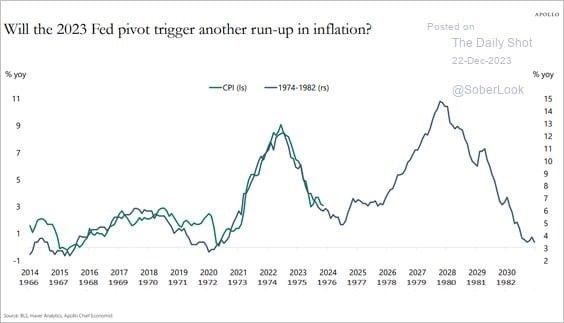
- Markets have seized on the possibility of a partial trade deal as well as some hopes that a hard Brexit will be avoided
- The main event for the day will be President Trump’s meeting with Vice Premier Liu He
- These market movements (if sustained) will take pressure off of the Fed to cut rates this month
- The notion of a “pathway” to a Brexit deal continues to capture investors’ imagination
- The EU will discuss sanctions on Turkey at next week’s summit; oil is up on news that an Iranian oil tanker was likely hit by a missile attack
- Singapore reported weak August retail sales data; Malaysia raised its budget deficit target for next year to -3.2% of GDP
The dollar is broadly weaker against the majors as risk-on sentiment continues to dominate. Sterling and Aussie are outperforming, while yen and Swissie are underperforming. EM currencies are mostly firmer. ZAR and KRW are outperforming, while TRY and INR are underperforming. MSCI Asia Pacific was up 1.1% on the day, with the Nikkei rising 1.2%. MSCI EM is up 1.1% so far today, with the Shanghai Composite rising 0.9%. Euro Stoxx 600 is up 1.4% near midday, while US futures are pointing to a higher open. 10-year UST yields are up 1 bp at 1.68%, while the 3-month to 10-year spread has steepened 1 bp and stands at +2 bp. Commodity prices are mostly higher, with Brent oil up 1.6%, copper up 0.5%, and gold flat.
Markets have seized on the possibility of a partial trade deal as well as some hopes that a hard Brexit will be avoided. It’s worth noting that the optimism continues across all markets today: FX, equities, bonds. EM and the growth-related majors (dollar bloc and Scandies) are outperforming, while global equity markets are rallying. Asian stock markets ran with this optimism overnight. US yields are rising and the US 3-month to 10-year curve is positively sloped for the first time since July 23. The thinking goes that even a partial trade deal reduces US recession risk and we would have to agree, at least for the near-term.
The main event for the day will be President Trump’s meeting with Vice Premier Liu He. Trump described the negotiations as going “very well,” fueling further gains in equity markets and a rising yields. A partial deal has now become the market’s (and our) base case, but it also means that the risk has shifted to a downside surprise that would wrongfoot bulls. For now, DXY is on track to test the September 13 low near 97.858, whilst EUR is on track to test its high from that day near $1.1110.
Indeed, we warn investors that a partial deal simply prevents things from getting worse. Our understanding is that in return for the currency pact and increased purchases of US goods by China, the US in turn would refrain from enacting any more tariffs and lifting sanctions on Huawei. Existing tariffs would remain in place and until those are removed by a broader trade deal, we think risks to global growth and trade remain in place.
THE AMERICAS
US reports September import/export prices and preliminary October Michigan sentiment (92.0 expected). Kashkari, Rosengren, and Kaplan speak. Interestingly, market movements (if sustained) will take a lot of pressure off of the Fed to cut rates this month. The positively sloped yield curve removes significant market risk, while rallying equities will help sustain positive sentiment and consumption. WIRP suggests 74% odds of a cut October 30, down from 82% yesterday. We think it will be a much closer call than that, especially if optimism on a partial trade deal continues.
Canada reports September jobs. Total employment is expected to rise 5k, with unemployment seen steady at 5.7%. Next policy meeting is October 30, no change is expected then. CAD is being boosted by risk-on sentiment as well as higher oil prices, with USD/CAD trading at the lowest level since October 2. Break below 1.3260 is needed to set up a test of that low near 1.3205.
EUROPE, MIDDLE EAST, AFRICA
Sterling is up over 1% on top of yesterday’s 2% gain as the notion of a “pathway” to a Brexit deal continues to capture investors’ imagination. Today’s catalyst was the comment by EC President Donald Tusk citing “promising signals” of progress. Never mind that neither Boris Johnson nor his Irish counterpart Leo Varadkar provided details about this pathway. But since Varadkar is the gatekeeper for constructive conversations with the EU, if he is sounding optimistic there must be hope. It’s just hard to imagine what Johnson could have offered. If there were a silver bullet, surely it would have been used earlier. Perhaps Johnson dangled some version of only thing Varadkar wanted to hear, a proposal for a customs border along the Irish Sea. If so, it’s hard to imagine how Johnson will convince Northern Ireland to go along, assuming he intends to.
Indeed any deal that Johnson offers still has to go through UK Parliament, which is suspended until the Queen’s Speech October 14. That leaves only days before the EU summit October 17-18. That summit is seen as the last chance to submit a deal that’s workable before the October 31 deadline. There may be enough movement from both sides to warrant a delay, but it still seems that a real deal by October 18 seems a stretch still. We remain skeptical and inclined to fade the move in sterling. Yes, it’s good to have a pathway, but it seems narrow and very hard to follow. The most likely outcome is still an extension of the Brexit deadline and more uncertainty ahead. Sterling is testing the September high near $1.2580. If this breaks, then the next big target is the June 25 high near $1.2785.
The EU will discuss sanctions on Turkey at next week’s summit. President Erdogan has already threated to “open the doors” for 3.6 mln refugees to enter Europe. Meanwhile, President Trump said the US had three choices: send in troops, impose sanctions on Turkey, or act as a mediator between the two sides. Asset prices are stabilizing this morning, in part due to better global risk appetite, but on the week, the lira has depreciated some 2.5% against the dollar, and would have probably moved more if it weren’t for government banks selling dollars. The Istanbul 100 index lost 4.2% on the week and 1-month rates are up 70 bps to 15.0%.
Oil futures are up nearly 2% this morning on news that an Iranian oil tanker was likely hit by a missile attack in the Red Sea. Some observers will surely try to blame Saudi Arabia, framing it as retaliation for the attacks against its facilities in mid-September. Either way, it looks like we are heading into a period of low-intensity conflicts and a proxy war between the region’s powers. This means that oil prices will remain volatile and investors will have to factor in a higher risk premium for the foreseeable future. But until we see the situation escalate to the point of closing the Strait of Hormuz and causing a squeeze in global oil supply, it shouldn’t have wider ramifications to markets.
ASIA
Singapore reported weak August retail sales data. Headline sales contracted -4.1% y/y vs. a revised -1.5% (was -1.8%) in July. Q3 GDP will be reported Monday and growth is expected at 0.2% y/y vs. 0.1% in Q2. MAS typically holds its semiannual policy meeting that same day. The MAS does not have an explicit inflation target, but low price pressures and the weak economic outlook should lead it to ease policy by adjusting the slope of its S$NEER trading band.
Malaysia raised its budget deficit target for next year to -3.2% of GDP from -3.0% previously. This was due mainly to a 7.1% drop in revenue. Like much of Asia, Malaysia has some room to enact fiscal stimulus in order to complement monetary stimulus. The government also raised its 2020 growth forecast a tick to 4.8%. Finance Minister Lim is also some spending next year for transport, energy and utilities but said that the government “remains committed to consolidating its fiscal deficit and debt level relative to GDP.” We see no rating implications from this news.
Full story here Are you the author? Previous post See more for Next postTags: Articles,Daily News,newsletter





























